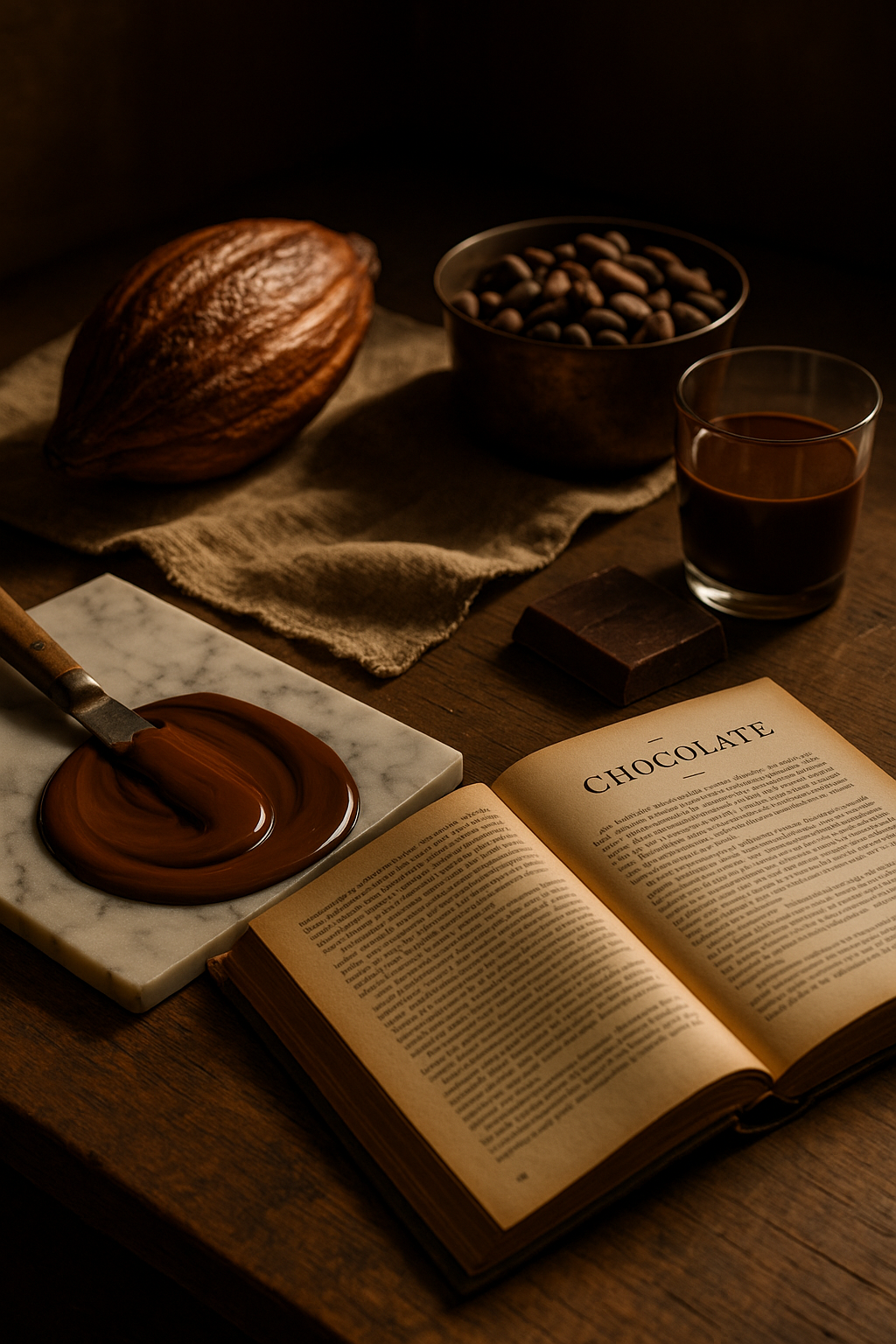Every craft has its language and chocolate is no exception.
From the rustle of a cabosse in the forest to the clean snap of a perfectly tempered bar, chocolate speaks through science, tradition, and time. Farmers, makers, and tasters all share this language a mix of chemistry and poetry where fermentation meets flavour, and terroir tells its tale.
This Chocolate Lexicon is your guide to that language: an A–Z of the terms, techniques, and textures that shape fine chocolate. Whether you’re a maker, a student, or simply a lover of flavour, here you’ll find the words behind the wonder the story inside every bar.
A
Agroforestry A sustainable farming system combining cacao trees with timber, fruit, and shade crops to restore soil, wildlife habitat, and climate balance.
Alkalisation (Dutch Processing) Treating cocoa with alkaline salts (usually potassium carbonate) to mellow acidity, deepen colour, and round flavour.
Artisan Chocolate Small-batch chocolate crafted by makers who control every stage, focusing on flavour, ethics, and transparency.
Astringency Dry, puckering mouth-sensation from cocoa polyphenols; desirable in balance for structure and complexity.
B
Bain Marie Gentle water bath technique for evenly melting chocolate.
Bean to Bar Chocolate made entirely in-house from bean selection to finished bar, ensuring traceability and flavour control.
Bloom Whitish film from fat or sugar migration; harmless but dulls gloss.
C
Cabosse (Cocoa Pod) Colourful fruit of Theobroma cacao containing cocoa beans.
Cacao Tree (Theobroma cacao) Tropical evergreen whose name means “food of the gods.”
Chocolate Liquor / Cocoa Mass Ground roasted nibs forming chocolate’s base.
Conching Extended mixing under heat to refine texture and develop flavour.
Couverture High-cocoa-butter chocolate (31–39 %) for moulding and enrobing.
Crystallisation Curve Temperature time profile showing cocoa butter crystal formation during tempering; guides precise texture control.
Criollo / Forastero / Trinitario The three main genetic groups of cacao: delicate Criollo, robust Forastero, and hybrid Trinitario.
D
Dark Chocolate Chocolate with cocoa solids, cocoa butter, and sugar, no milk solids.
Direct Trade Buying cocoa directly from farmers to ensure fair prices and transparency.
Dragée (Dragee) Nuts or fruit coated in successive chocolate layers by panning.
E
Emulsification Blending fats and water-based ingredients for smooth texture.
Enrobing Coating centres with a thin layer of tempered chocolate.
Ethical Sourcing Purchasing that supports farmers, biodiversity, and fair labour.
F
Fairtrade Certified Guarantees fair pay, safe work, and sustainable farming for cocoa growers.
Fermentation Natural microbial process developing cocoa’s flavour precursors.
Flavour Wheel Visual guide to chocolate’s aroma and flavour spectrum.
Finish (Aftertaste) Flavour sensations that linger after swallowing; hallmark of fine chocolate.
G
Ganache Smooth mix of chocolate and cream for truffles or glazes.
Gianduja (Gianduia) Italian blend of chocolate and hazelnut paste.
Grand Cru Premium term for chocolate from exceptional single-origin beans.
Grinding Mechanical reduction of nibs into smooth liquor.
H
Hand Tempering Marble-slab method creating stable cocoa-butter crystals.
Hot Chocolate Beverage of melted chocolate or cocoa powder with milk or water.
Hygroscopicity Chocolate’s tendency to absorb moisture, risking sugar bloom.I
I
nclusions Added ingredients (nuts, fruit, spices) for texture and flavour.
Infusion Steeping flavours like vanilla or tea in cream before mixing with chocolate.
Intercropping Growing cacao among shade or food crops for biodiversity.
J
Java Cocoa Indonesian cocoa noted for mild acidity and tobacco-like undertones.
Judging Sensory evaluation assessing aroma, flavour, and texture.
K
Koji Fermentation Using Aspergillus oryzae (from sake/miso culture) to deepen umami complexity.
Kokoa Akan word for cocoa, used widely across Ghana.
L
Lecithin Natural emulsifier improving flow and stability.
Liquor (Cocoa Mass) Pure ground nibs forming chocolate’s foundation.
Living Income Differential (LID) Premium introduced by Ghana and Côte d’Ivoire to raise farmer incomes above poverty level.
Lustre Dust Edible metallic powder adding shimmer.
M
Melanger Granite stone grinder refining nibs into smooth chocolate.
Micron Size Average particle size (≈ 15–25 µm) determining smoothness.
Milk Chocolate Blend of cocoa, milk solids, sugar, and cocoa butter.
Moulding Pouring tempered chocolate into shapes or bar moulds.
Mouthfeel Tactile sensations of texture, viscosity, and melt on the palate.
N
Nacional Cocoa (Arriba) Ecuador’s floral-aromatic variety with jasmine notes.
Nibs (Cocoa Nibs) Cracked roasted beans for crunch and flavour.
Nougatine Caramelised nut brittle, often enrobed or mixed with chocolate.
O
Origin Geographic source of cocoa defining terroir and flavour.
Organic Chocolate Made from certified organic ingredients without synthetics.
Over-Tempering Excess cooling producing thick, grainy flow.
P
Panning Drum-coating process layering chocolate over nuts or fruits.
Percentage of Cocoa Total cocoa solids + butter content in a bar.
Pulp (Cocoa Mucilage) Sweet white fruit around beans; essential in fermentation and by-products like cocoa vinegar.
Q
Quick Tempering Seeding melted chocolate with tempered pieces for rapid stabilisation.
Quetzalcoatl Aztec deity said to have gifted cacao to humankind.
Quality Control Continuous testing ensuring consistency and flavour integrity.
R
Refining Grinding particles to 15–25 µm for silky melt.
Roasting Controlled heating to develop aroma and loosen shells.
Rheology Study of chocolate’s flow and viscosity behaviour.
Retro-Nasal Aroma Flavour perceived when aromas travel from mouth to nose during tasting.
S
Semisweet Chocolate 50–60 % cocoa solids; balanced sweetness.
Single Origin Chocolate from beans of one region for distinct terroir.
Snap Clean break sound signalling perfect temper.
Sustainability Practices that protect farmers, soil, and planet.
Shear Rate Speed of chocolate flow during mixing; affects viscosity and coating.
T
Tempering Heating and cooling chocolate to form stable Type V crystals.
Terroir Soil, climate, and post-harvest factors shaping flavour.
Theobromine Natural stimulant in cacao, related to caffeine but milder.
Traceability Ability to follow cocoa from farm to finished bar; vital for ethical sourcing.
Truffle Ganache-based confection rolled or coated in chocolate.
U
Umami Savoury depth created during fermentation.
Unsweetened Chocolate Pure cocoa liquor with no added sugar.
Unroasted (Raw) Chocolate Made from unroasted beans for bright acidity.
V
Vegan Chocolate Made without dairy; often oat or coconut-based mylkstyles.
Viscosity Thickness of flow; crucial for moulding and enrobing.
Volatile Aromas Delicate compounds forming chocolate’s bouquet.
W
White Chocolate Cocoa-butter-based chocolate without cocoa solids.
Whole Pod Philosophy ™ Coeur de Xocolat’s ethos of using every part of the cacao fruit for flavour and zero waste innovation.
Winnowing Separating roasted nibs from husks after cracking.
X
Xocoatl Original Aztec spiced cacao drink; ancestor of modern hot chocolate.
Xylitol Naturally derived sweetener used in sugar-free chocolate for gentle sweetness.
Xocolatl / Chocolatl (Etymology) Evolution of the Nahuatl word through Spanish into “chocolate.”
Y
Yeast Microorganisms driving cocoa-bean fermentation and flavour.
Yorkshire Chocolate Heritage Celebrates Britain’s chocolate making cradle: Rowntree’s of York, Terry’s, and Thorntons.
Yield Stress Point where chocolate begins to flow under pressure, affecting coating quality.
Z
Zero-Waste Cocoa Full-use processing turning husks, pulp, and shell into new products such as cocoa vinegar or ash.
Zest Infusion Flavouring chocolate with citrus-peel oils for brightness.
Zymology Scientific study of fermentation vital to cocoa chemistry
Chocolate is a living language part craft, part chemistry, part culture.
With this A–Z by your side, you can taste, teach, and talk chocolate like a true expert.
